Issues to be Covered
- Health outcomes associated with human trafficking.
- Impact on a health care organization.
- Potential risks for a health care organization.
- Strategies for addressing the issue in health care settings.
- The role of the health care manager.
- Conclusion.
Human Trafficking, which is a modern form of slavery, is a critical issue nowadays since it affects many marginalized people around the world. Its victims suffer from different physical and mental diseases, but medics have difficulties with rescuing them from their situation because sometimes, they cannot identify trafficked patients. In this presentation, health outcomes associated with human trafficking will be observed to prove that it is a healthcare problem. Furthermore, the potential impact and risks of this issue for healthcare organizations will be discussed. Finally, the strategies for addressing this problem in health care settings will be suggested and the role of the health care manager will be analyzed.
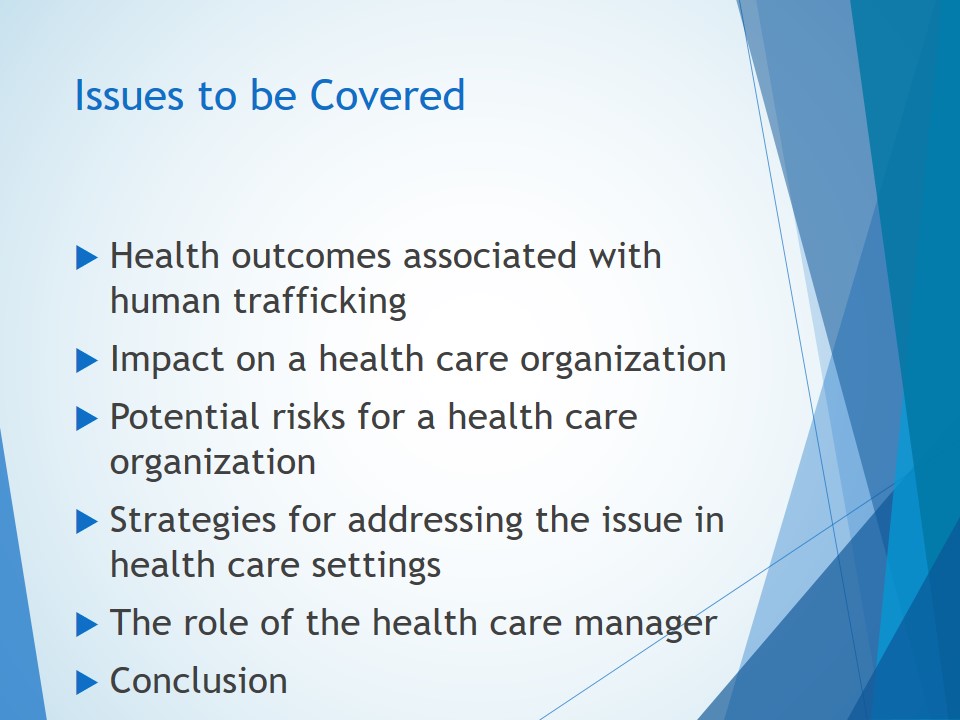
Health Outcomes Associated with Human Trafficking
- Acute injuries.
- Sexually transmitted infections (STIs).
- Unintended pregnancy.
- Worsening of chronic diseases.
- Posttraumatic stress disorder.
- Suicide.
Human trafficking may be regarded as a social and legal issue, but it is also a healthcare problem since trafficked people are subject to various morbid conditions. Trafficking victims often suffer from acute injuries received as a result of manual work in hazardous conditions or physical and sexual abuse (Macias-Konstantopoulos, 2016). Furthermore, sexual assaults may cause sexually transmitted infections and unintended pregnancy (Macias-Konstantopoulos, 2016). Trafficked people with chronic diseases may experience the aggravation of symptoms because of lack of treatment (Macias-Konstantopoulos, 2016). Finally, trafficking victims undergo severe anxiety leading to posttraumatic stress disorder or the attempts to harm themselves, which may end in a suicide. Thus, human trafficking is a serious healthcare issue that impacts healthcare organizations and, therefore, should be addressed by medical staff.
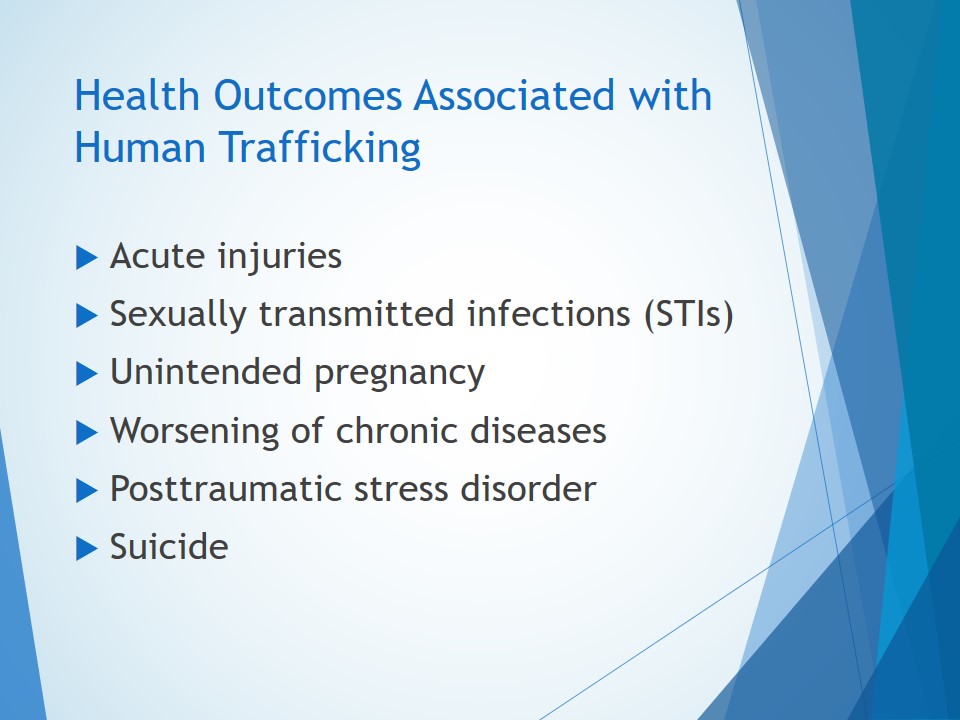
Impact on a Healthcare Organization – Human Trafficking
- Need for training nurses to identify trafficking victims.
- Necessity for an interpreter.
- Need for resources promoting the knowledge of protection available to victims.
The impact of human trafficking on healthcare organizations lies in the need for educating nursing staff to recognize trafficking victims and providing personnel with the necessary resources for treating such patients. For example, trafficked people sometimes do not have a good command of the language of the country they are brought to, so nurses should be provided with an interpreter to communicate with them (Byrne, Parsh, & Parsh, 2019). Moreover, since the protection available to trafficking victims differs from state to state, healthcare organizations have to make sure they provide their staff with the relevant information (Byrne et al., 2019). Implementing these measures requires additional expenditure of money, time, and effort.
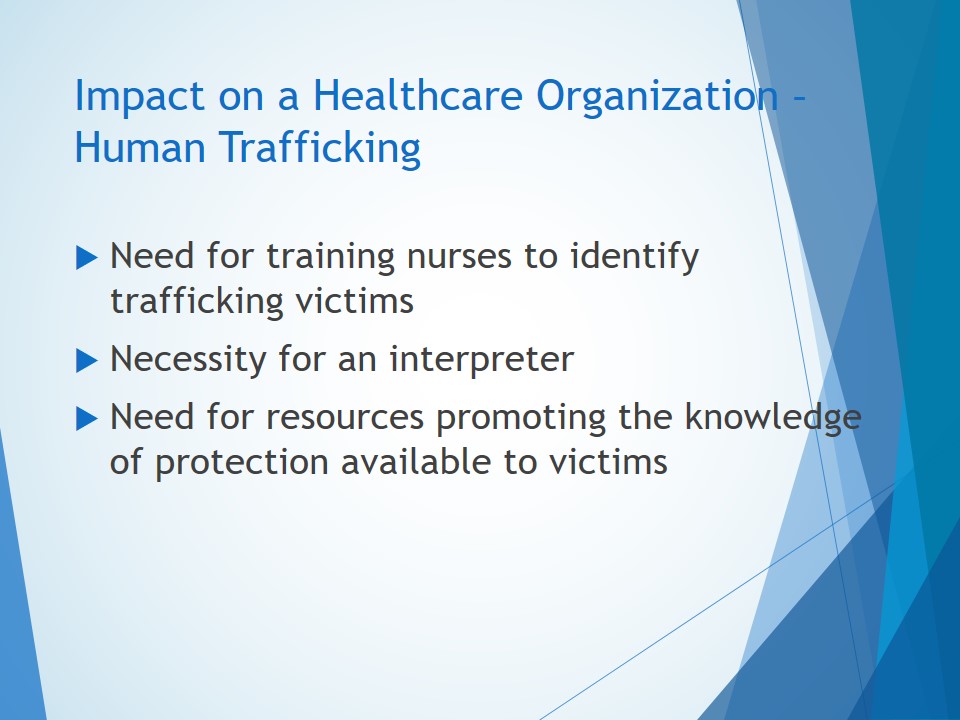
Impact on a Healthcare Organization – Organ Trafficking
- Increased load on hospitals because of complicated treatment.
- Imported microorganisms as a health hazard.
- Public discredit of transplantation.
Human trafficking for the purpose of selling human organs for transplantation has a more serious impact on healthcare organizations. If organ donor and recipient come from different regions, the transplantation will result in complications, which will cause a hospital to spend additional resources for treatment (Domínguez-Gil, López-Fraga, Muller, & Gill, 2017). Furthermore, such transplantation may lead to infecting the recipient with geographically restricted and not easily detected microorganisms, which may lead to organ failure (Domínguez-Gil et al., 2017). Finally, the existence of human trafficking results in public distrust of voluntary donation, as well as the procedure of transplantation (Domínguez-Gil et al., 2017). Thus, forced organ donation of trafficking victims harms healthcare organizations alongside individuals.
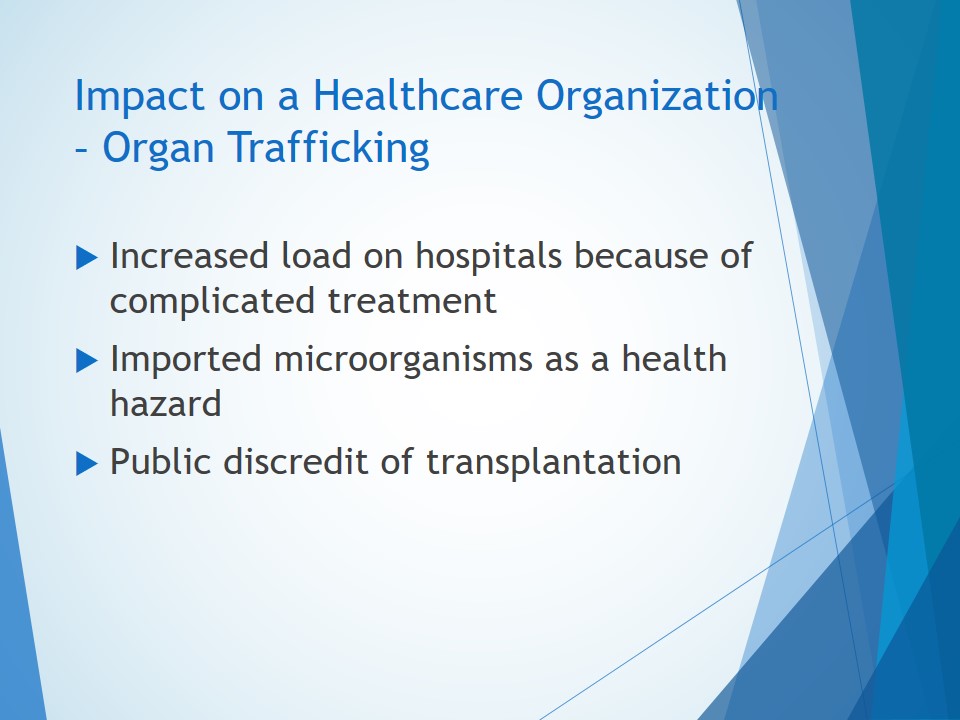
Risks for a Healthcare Organization
- Risk of failing to identify trafficking victims due to:
- Distrust of the medical staff;
- Hesitation about leaving trafficking.
Perhaps, the only risk of human trafficking for healthcare organizations is that medical personnel may fail to identify trafficking victims among their patients. It has been found that over 80% of female survivors were examined by medical staff, but none of them were recognized as trafficking victims (Macias-Konstantopoulos, 2016). Healthcare professionals may fail to identify trafficked patients since victims often do not trust other people, including the medical staff, due to stress or intimidation by traffickers (Judge, Murphy, Hidalgo, & Macias-Konstantopoulos, 2018). Trafficked people may also hesitate to leave trafficking because of drug addiction or the threat of law enforcement (Judge et al., 2018). Therefore, healthcare organizations risk failing to cope with the issue of human trafficking unless they educate their personnel to identify its victims.
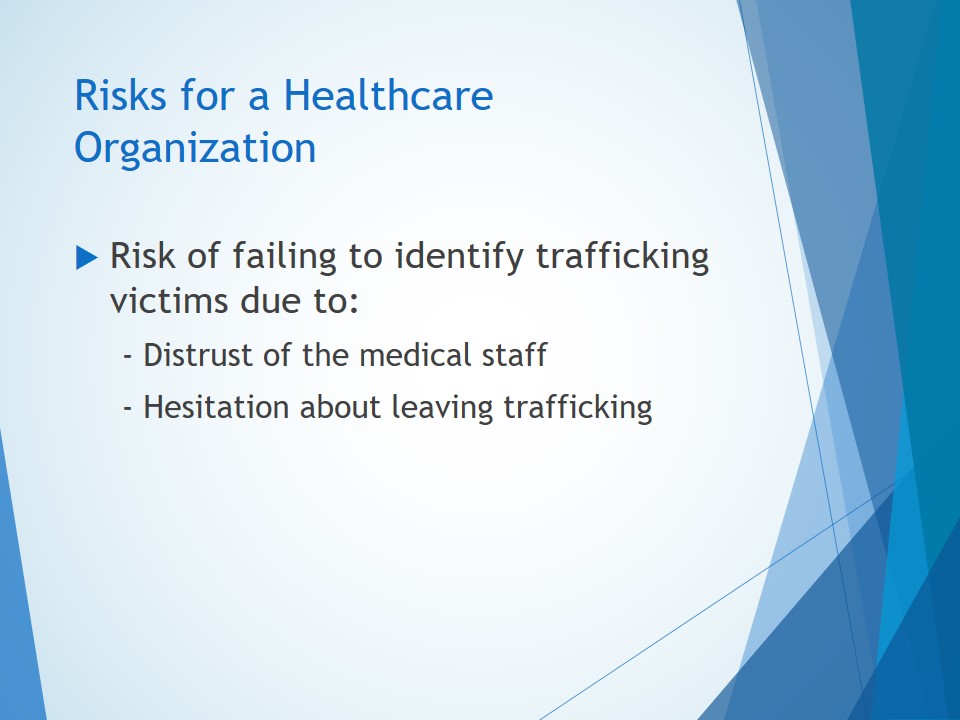
Strategies for Addressing the Issue in Health Care Settings – Identification
- Paying attention to physical and behavioral signs;
- Building trust between a healthcare professional and a patient:
- Avoiding aggressive ways of disclosure.
- Interviewing in person.
The primary strategy for addressing human trafficking is learning to identify trafficking victims. Healthcare professionals should pay attention to their patients’ suspicious behavior, such as experiencing fear or anxiety, and physical signs, including STIs, repeated abortions, bruises etc. (Byrne et al., 2019). If a patient seems to be trafficked, it is necessary to build trust with him or her, which is achievable by avoiding aggressive attempts to disclose trafficking (Macias-Konstantopoulos, 2016). Healthcare professional should speak to patients in private since trafficking victims sometimes attend hospitals with their traffickers who may prevent disclosure (Macias-Konstantopoulos, 2016). Thus, identification of trafficked people in healthcare settings is the first step in dealing with the issue.

Strategies for Addressing the Issue in Health Care Settings – Intervention
- Providing victims with medical care, shelter, and safety.
- Informing community organizations about the cases of human trafficking.
After identifying trafficking victims, healthcare professionals need to know how to rescue them from their slavery safely. First of all, the medical staff should provide trafficked patients with the necessary medical care, shelter, and safety (Byrne et al., 2019). Healthcare professionals should be aware of community organizations helping trafficking victims, such as social services and substance abuse clinics, and report the cases of human trafficking to them (Byrne et al., 2019). The purpose of it is making sure that patients are safe and protected from returning to human trafficking. Moreover, providing trafficking victims with the assistance of social services will help them to integrate into society. For this reason, healthcare organizations should establish contacts with other organizations involved in dealing with human trafficking.
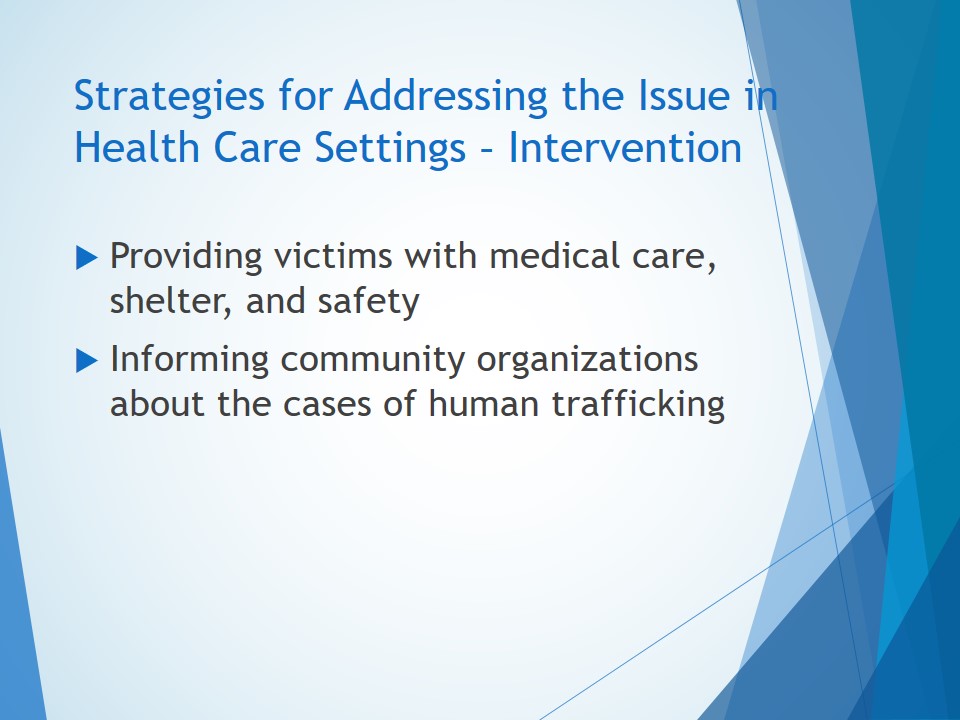
Strategies for Addressing the Issue – Prevention at the Individual Level
- Identifying potential victims.
- Educating potential victims about recruitment techniques of traffickers.
- Assisting potential victims in receiving help from social workers.
Healthcare organizations should not only intervene in already existing cases of human trafficking but also prevent future ones. Healthcare professionals should identify potential victims of human trafficking based on a set of risk factors, such as runaway behavior, lack of family support, or exposure to violence (Greenbaum et al., 2018). When potential victims are identified, the medical staff should provide them with the information about common techniques, which human traffickers use to recruit people (Greenbaum et al., 2018). Since healthcare organizations should be aware of and partnered with community organizations that provide assistance to the victims of human trafficking, they may help potential victims to receive the necessary support from social workers.
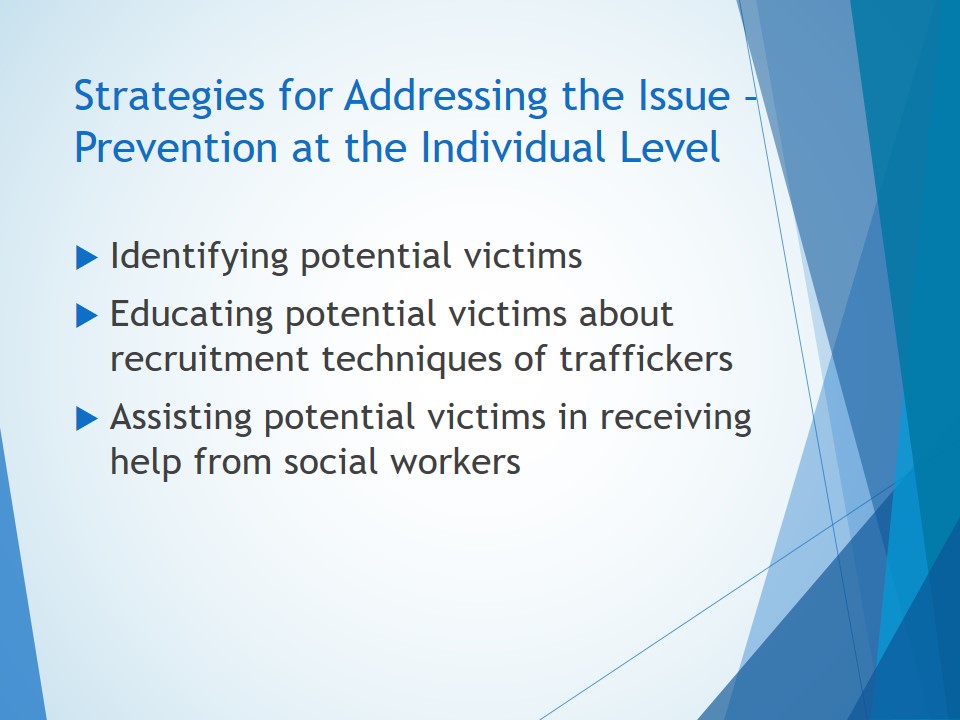
Strategies for Addressing the Issue – Prevention at the Society Level
- Educating people about risks of human trafficking.
- Conducting research on human trafficking risk factors.
Healthcare organizations should take preventive measures at the society level as well. These actions include educating people about the risks of human trafficking beyond the healthcare settings and conducting research on risk factors leading to human trafficking (Greenbaum et al., 2018). It is necessary to promote the knowledge of human trafficking to the entire population, especially its most vulnerable segments, such as adolescents. Carrying out research is essential for detecting the factors that make a person a desired prey for human traffickers. The obtained data will be of great value to healthcare professionals interacting with patients since they will be able to identify potential and current trafficking victims more precisely and develop effective ways of handling the issue.
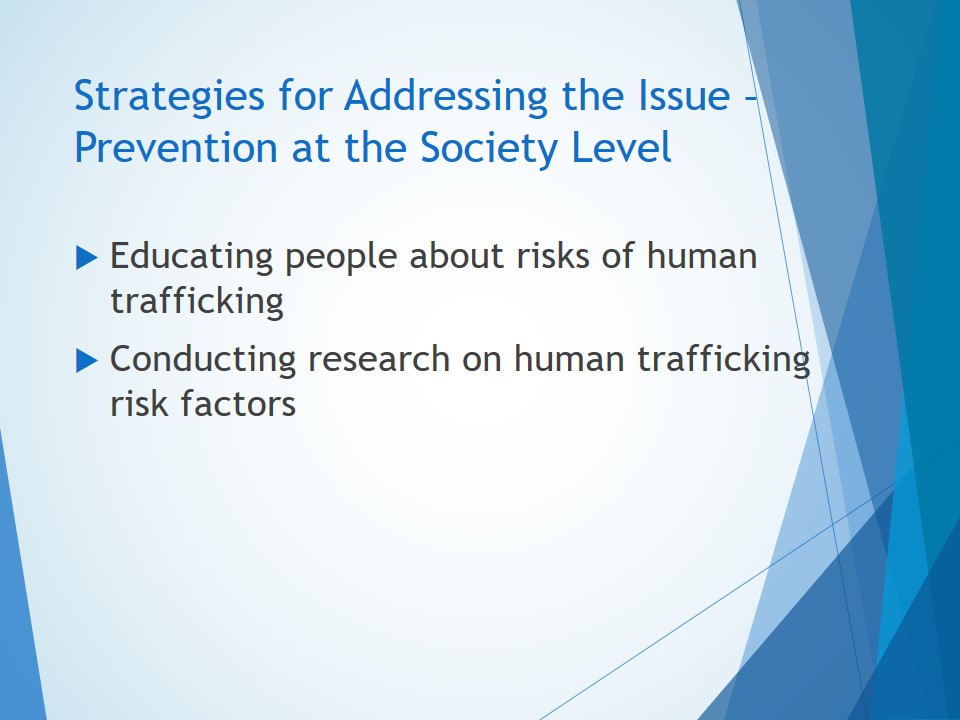
The Role of the Health Care Manager
- Training staff to identify and help victims of human trafficking:
- Educating nurses about distinctive signs of trafficking victims;
- Providing information about state regulations;
- Establishing a collaboration between healthcare and community organizations;
- Developing policies and protocols guiding the work of the medical staff.
Healthcare managers have a significant role in implementing the mentioned strategies. Primarily, they should ensure that nurses in their healthcare organizations are trained to identify victims of human trafficking and provide them with the necessary aid (Byrne et al., 2019). The medical staff should be educated about the physical and behavioral signs of trafficked people. Since there are some discrepancies between federal and state regulations of human trafficking, the manager should provide nurses with the relevant information about procedures applied to trafficking victims in the given state (Byrne et al., 2019). These measures will improve the amount of people rescued from human trafficking and increase public awareness of the issue.
Another significant role of healthcare managers is the establishment of collaborations between a healthcare organization and other community organizations intended to help trafficking victims. Medical care is not enough for patients subject to human trafficking. Therefore, healthcare managers should make sure their health care organization has established contacts with social services and other facilities to ensure patients’ safety. Healthcare managers should develop protocols and policies, which would regulate the work of the medical personnel related to trafficking victims (Byrne et al., 2019; Macias-Konstantopoulos, 2016). It will ensure that nurses’ actions as to handling trafficking victims are consistent throughout the healthcare organization.

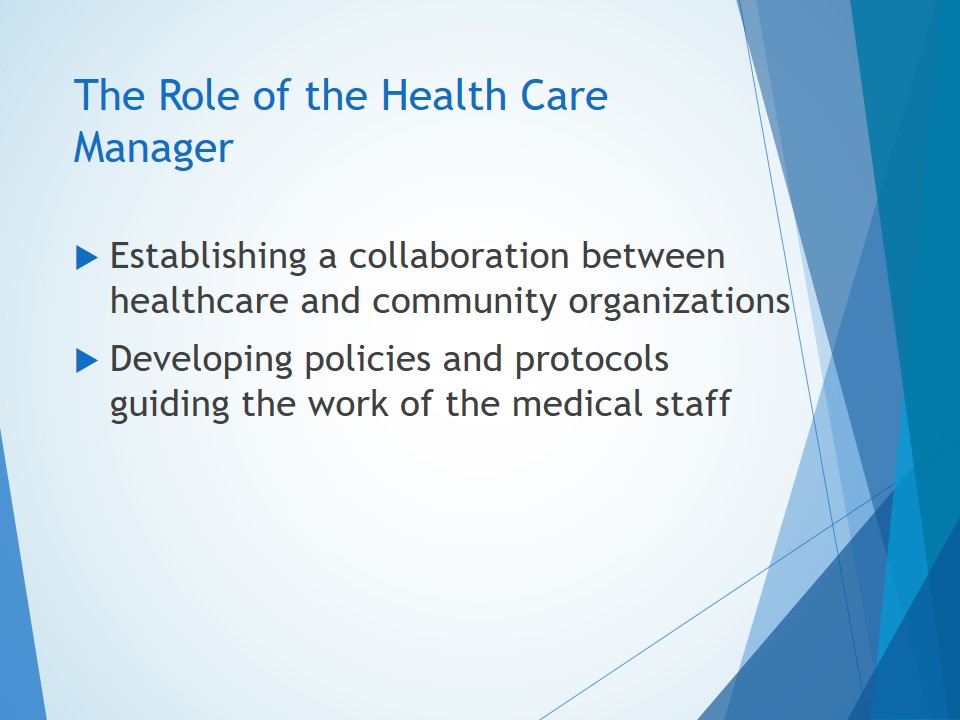
Conclusion
- Human trafficking is a crucial healthcare problem.
- The need for identifying trafficking victims.
- Collaboration between healthcare organizations and social services.
Human trafficking is a crucial healthcare problem since it results in a variety of severe health outcomes for its victims. The difficulty of dealing with it lies in the need for identifying trafficking victims in the healthcare setting. Healthcare organizations face the risk of failing to identify the victims of human trafficking, which prevents them from handling this issue. To address this problem, healthcare managers should provide training for the medical personnel to teach them to identify the distinctive features of trafficked patients. Furthermore, the collaboration between healthcare organizations and social services is necessary for ensuring trafficking victims’ safety. Finally, specific policies and protocols may be helpful to make sure the medical staff is aware of the issue and acts according to the established rules.
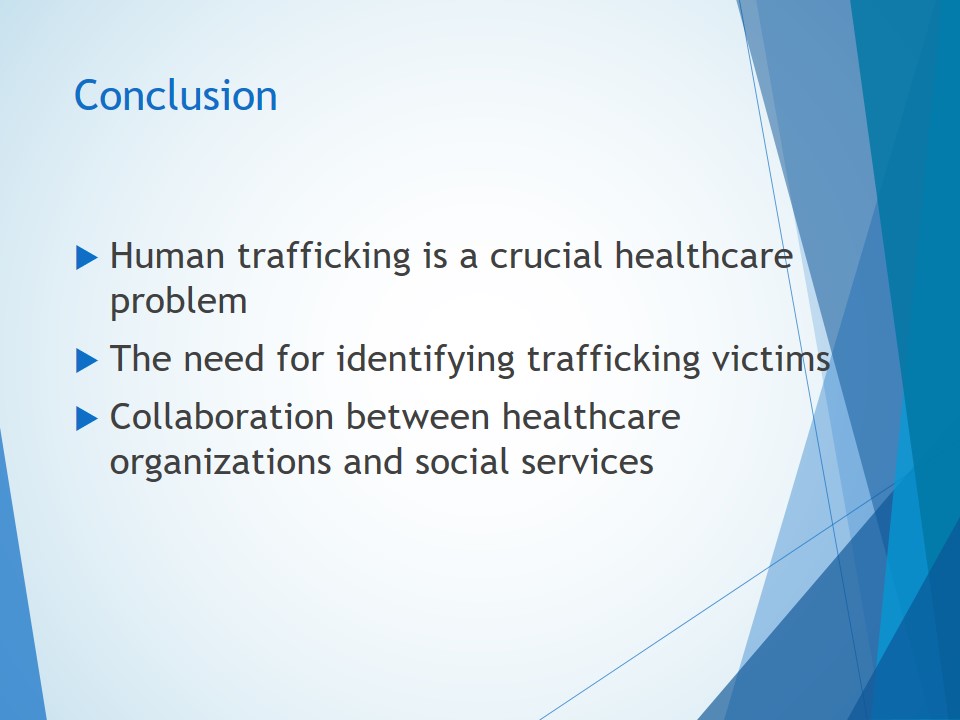
References
Byrne, M., Parsh, S., & Parsh, B. (2019). Human trafficking: Impact, identification, and intervention. Nursing Management, 50(8), 18-24.
Domínguez-Gil, B., López-Fraga, M., Muller, E., & Gill, J. S. (2017). The key role of health professionals in preventing and combating transplant-related crimes. Kidney International, 92(6), 1299–1302.
Greenbaum, V. J., Titchen, K., Walker-Descartes, I., Feifer, A., Rood, C. J., & Fong, H. (2018). Multi-level prevention of human trafficking: The role of health care professionals. Preventive Medicine, 114, 164–167.
Judge, A. M., Murphy, J. A., Hidalgo, J., & Macias-Konstantopoulos, W. (2018). Engaging survivors of human trafficking: Complex health care needs and scarce resources. Annals of Internal Medicine, 168(9), 658-664.
Macias-Konstantopoulos, W. (2016). Human trafficking: The role of medicine in interrupting the cycle of abuse and violence. Annals of Internal Medicine, 165(8), 582-589.